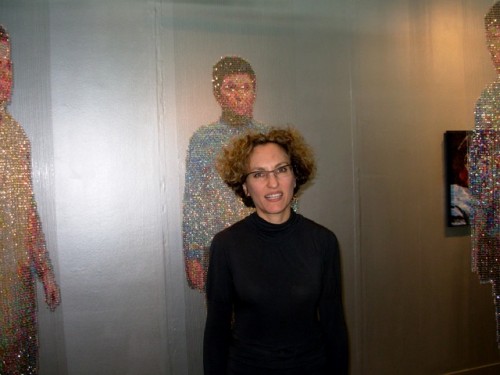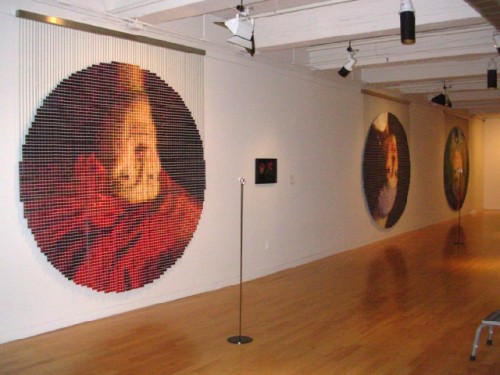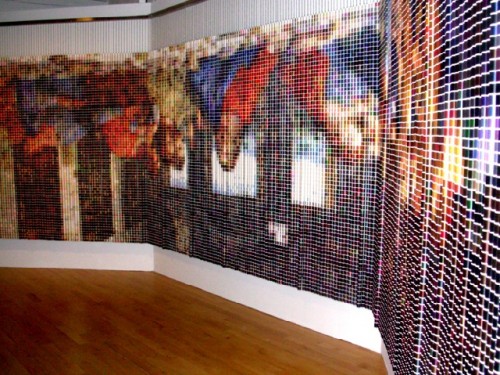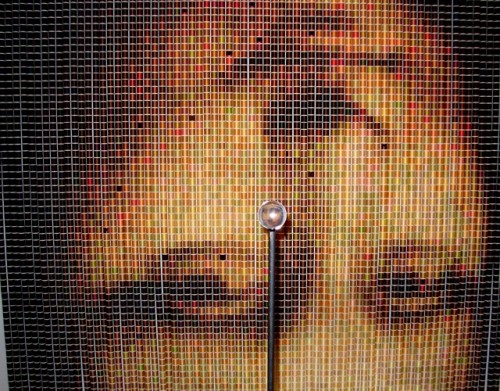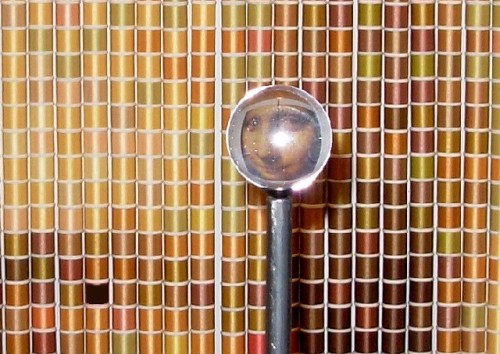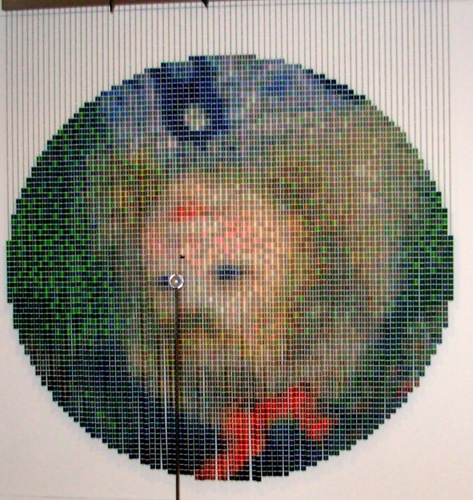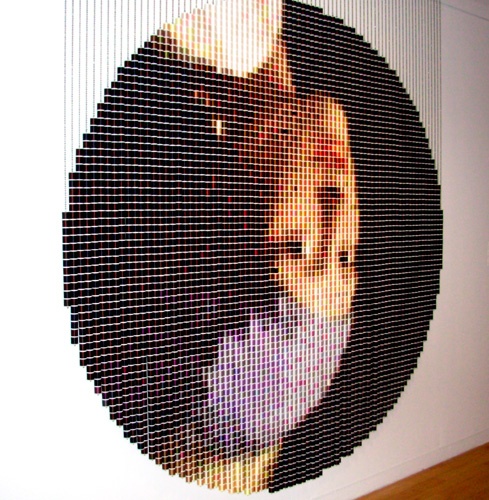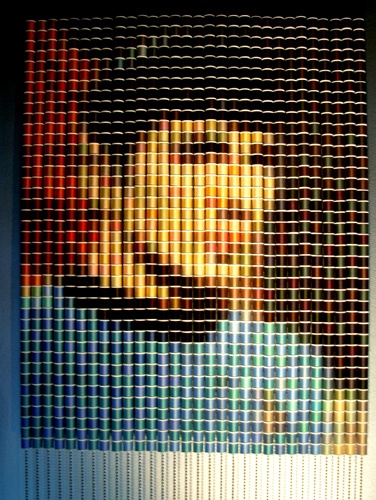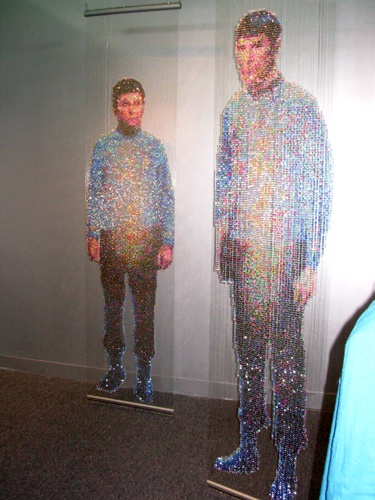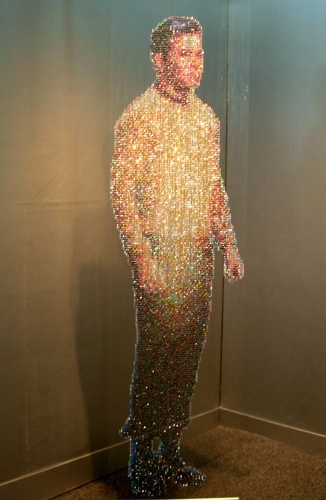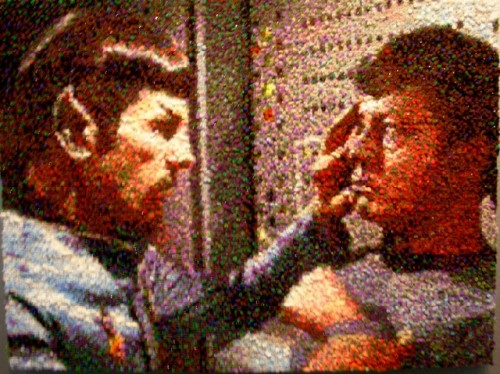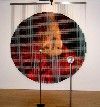Kidspace Exhibit: Devorah Sperber at Mass MoCA
The Last Supper Recreated in 20,736 Spools of Thread
By: Charles Giuliano - Apr 12, 2008
Devorah Sperber: Interpretations
Organized by Laura Thompson
Kidspace at Mass Moca
On view to the public Saturday and Sunday
http://www.massmoca.org
http://www.devorahsperber.com
While touring the Pulse New York art fair recently I first encountered the work of Devorah Sperber. It seemed to fit the description by Mass MoCA installer, Richard Criddle, who articulated the labor intensive process of mounting the show in Kidspace on the third floor of the enormous contemporary art museum in North Adams.
The artist seemed surprised when I asked if she were currently showing at Mass MoCA. "The show only opened last week" she said and asked if I had seen it. Actually, not at the time. But the technique of making reproductions of iconic images with "pixels" meticulously assembled through multi colored, beaded curtains and grids of spools of thread is so unique that I proved to be on target. For Pulse she was showing several beaded curtains based on the Science Fiction series "Star Trek." It was eerie how precisely she replicated the process of Dr. Spock, Captain Kirk, and others being teleported from a planet's surface to the Starship Enterprise. The phrase "Beam me up Scottie" is etched into the subconscious of a generation of fans. Of course, the camp actor, William Shatner, now far more rotund and deranged, portrays the entertaining and total gonzo, Denny Crane, a lovable attorney who suffers from Mad Cow Disease on "Boston Legal."
The installation at Mass MoCA proves to be far more ambitious and complex than the tantalizing glimpse of Sperber's work at Pulse. Back on our home turf in the Berkshires we were able to slow down and fully appreciate her unique and inventive, playful work. Perhaps it is for this reason, as well as how it aptly illustrates aspects of the confluence of art/ science/ technology and yes, even a bit of Feminism, that the work has been installed in Kidspace. During the week it is an area where school groups come for educational programming. An under promoted aspect of Mass MoCA is the enormous impact it is having on local schools. Kids in the Northern Berkshires also get to visit the Clark Art Institute as well as the Williams College Museum of Art. In fact these institutions collaborate on Kidspace and its programming.
While that is the good news the down side is that Kidspace is open to the general public only on weekends and during school vacations. On the Saturday when we visited, while Mass MoCA was packed, as usual, there were only a couple of people whom we encountered viewing Sperber's installation. Of course, any artist is delighted to have the opportunity to show at Mass MoCA but this show, typical of those organized by Laura Thompson who runs Kidspace, while great for children, really deserves more attention and promotion.
Sperber's work has been widely shown including a major exhibition at the Brooklyn Museum. But, because it involves a "trick" and appropriates vignettes of Old Masters, arguably, it does not get the level of respect that it deserves. There are a lot of artists out there redoing Old Masters in one way or another but hardly with the wit and labor intensity on view here. This really enjoyable and absorbing exhibition deserves to be seen down stairs at Mass MoCA standing cheek to jowl with the big boys (and girls). Perhaps a poster or signage in the lobby would help to direct traffic to the off the beaten path, third floor during weekend hours.
The "feminist" aspect of the work may be embedded in the choice of material, spools of thread, beading, and methodical, demanding intensity of assembly. In that sense this is "woman's work." And because it deconstructs and reproduces already iconic imagery it is lacking in "originality" beyond its unique technique, and hence may lack "importance."
Take, for example, the "Mona Lisa" of Leonardo da Vinci. Marcel Duchamp created two versions (perhaps more) of an appropriation (which he concocted to the eternal fate of the art world). In one he drew a moustache on a playing card sized commercial reproduction. For another "Shaved" version, without moustache, he wrote below "L.H.O.O.Q." Which if spelled out quickly in French is a pun that roughly translates as "She has hot pants." There is no such testosterone saturated wit in the version created by Sperber. Using a computer program the small portrait from the Louvre has been broken up into a grid of pixels. This is readily familiar to anyone who has taken a detail of an image in Photoshop and greatly enlarged it. It is also a familiar exercise in foundation classes at art schools where students are assigned to pixelate an image and create a rendering in grid format.
If we stand close to Sperber's works we are acutely aware of the elements; endless spools of thread. In the case of her "Mona Lisa" some 5,184 thread spools to be precise. Another aspect of the work is that the assemblage, or relief sculpture, is suspended upside down. In front of the piece is a small clear sphere. If we examine it through this device we find the "painting" inverted and quite legible as the "Mona Lisa."
In an artist's statement she explains that "Photons bouncing off the spools of thread reach our eyes where they are turned into a pattern that is sent to the primary visual cortex where the rough shapes are recognized. The pattern is then sent to higher regions where colors are recognized and where thread-spool identities are encoded along with other knowledge we already have about thread spools. This direct flow is called feed forward, meaning the data is moving from bottom to top (eyes to brain).
"Bundles of nerve cells carry information. Traffic flowing from top to bottom is called feedback or top-down processing. There are 10 times as many nerve fibers carrying information down as there are carrying it up. So what we see is based on what neuroscientists call 'top down processing.' And what we see depends on the framework built by past experience that interprets raw data. In other words, the brain is assembling or projecting what it knows about an object into a recognizable image."
In addition to the da Vinci "Mona Lisa" there are several other, large scale, details of appropriations "After Vermeer 2" (2006) a tribute to "Girl with a Pearl Earring," "After van Eyck" (2006), two versions, a tribute to "Man with a Red Turban" "After Grant Wood" (2006) a tribute to "American Gothic" "After Renoir" (2006) a tribute to "Girl with a Watering Can" "After the Last Supper" (2005) a tribute to Leonardo da Vinci.
"The Last Supper" which is installed on angled walls as a triptych entails a staggering 20,736 thread spools. Good heavens. Or, as we learn in Macbeth, "Sleep knits up the raveled sleeve of care."

